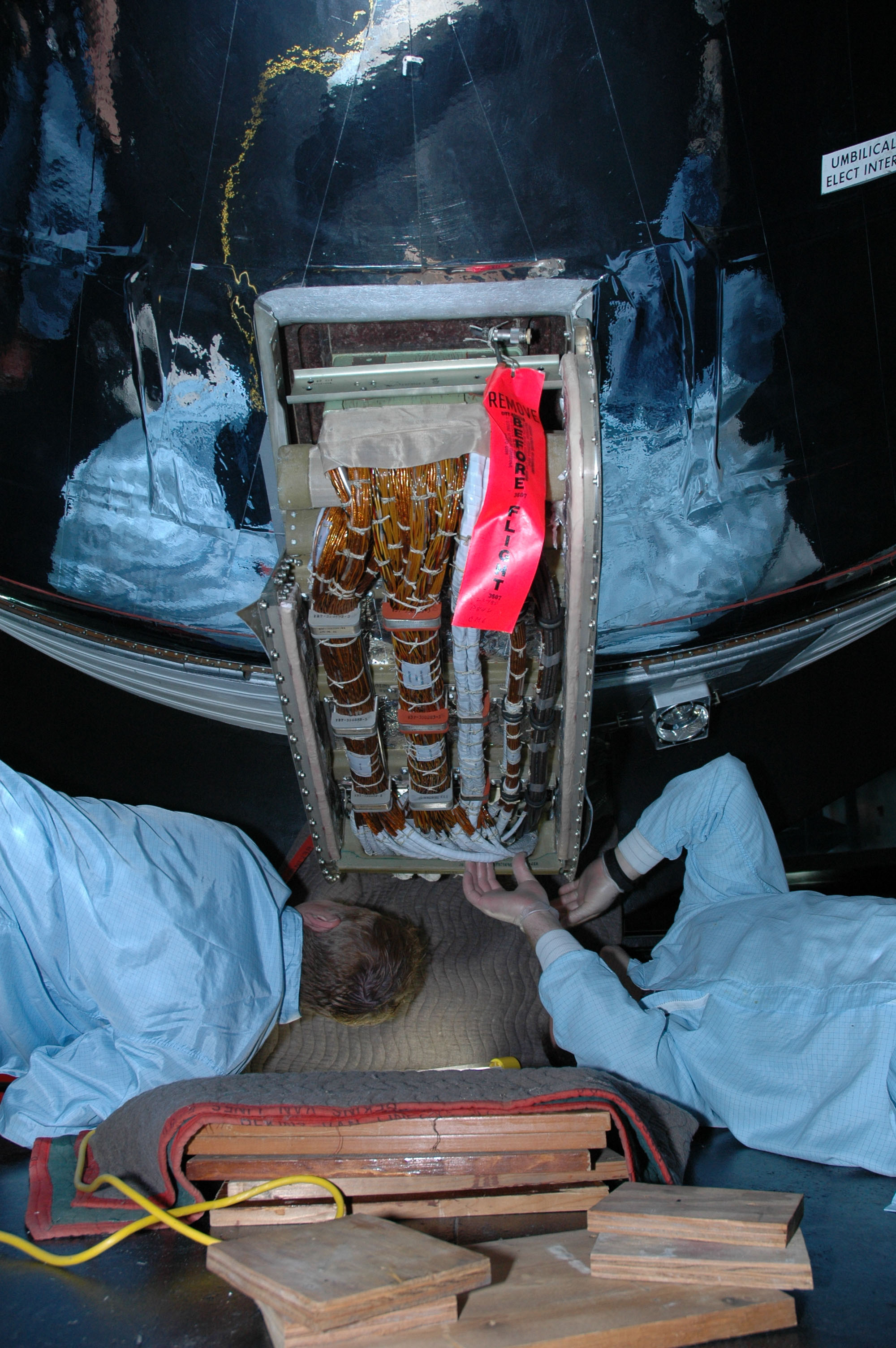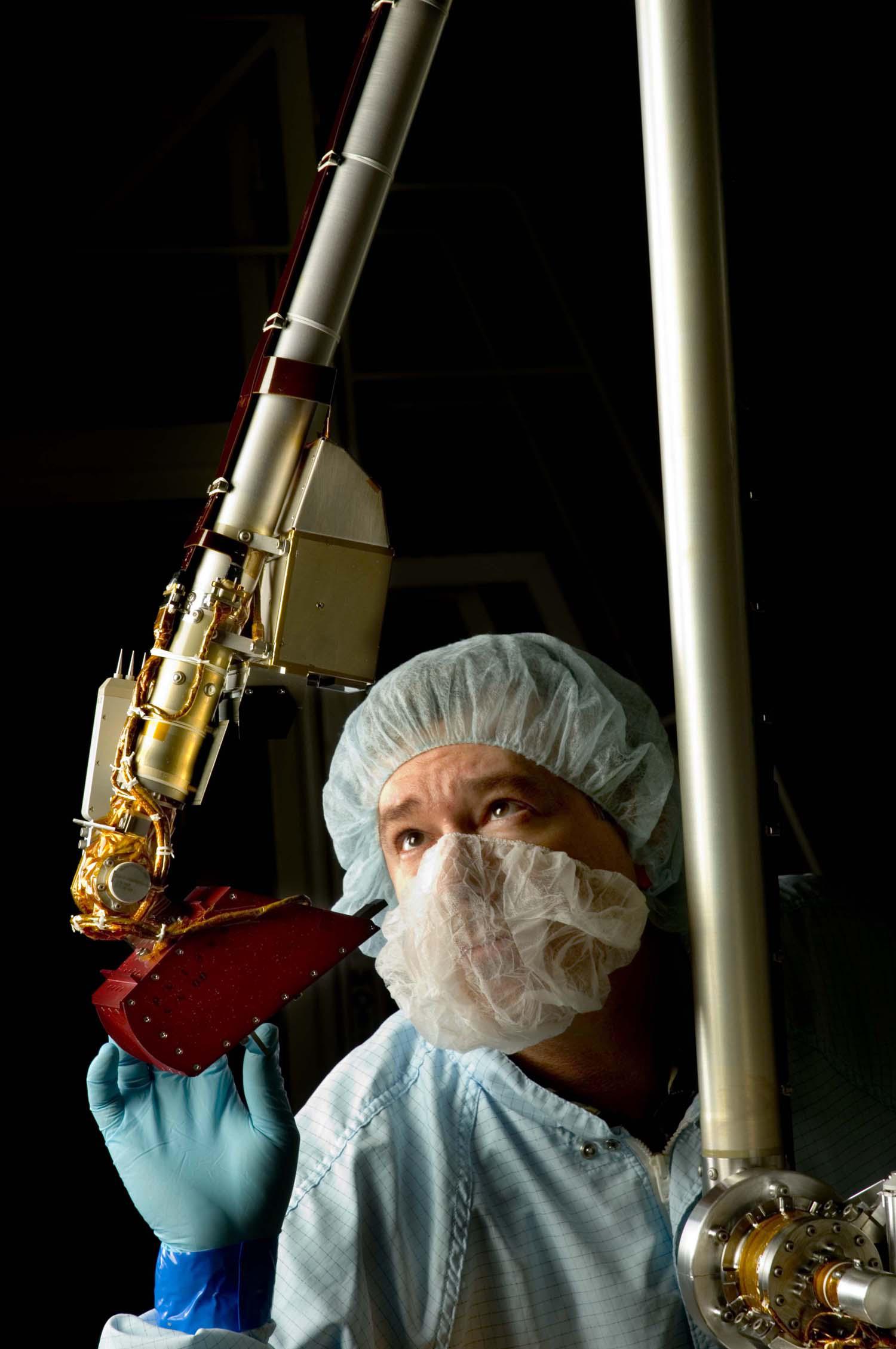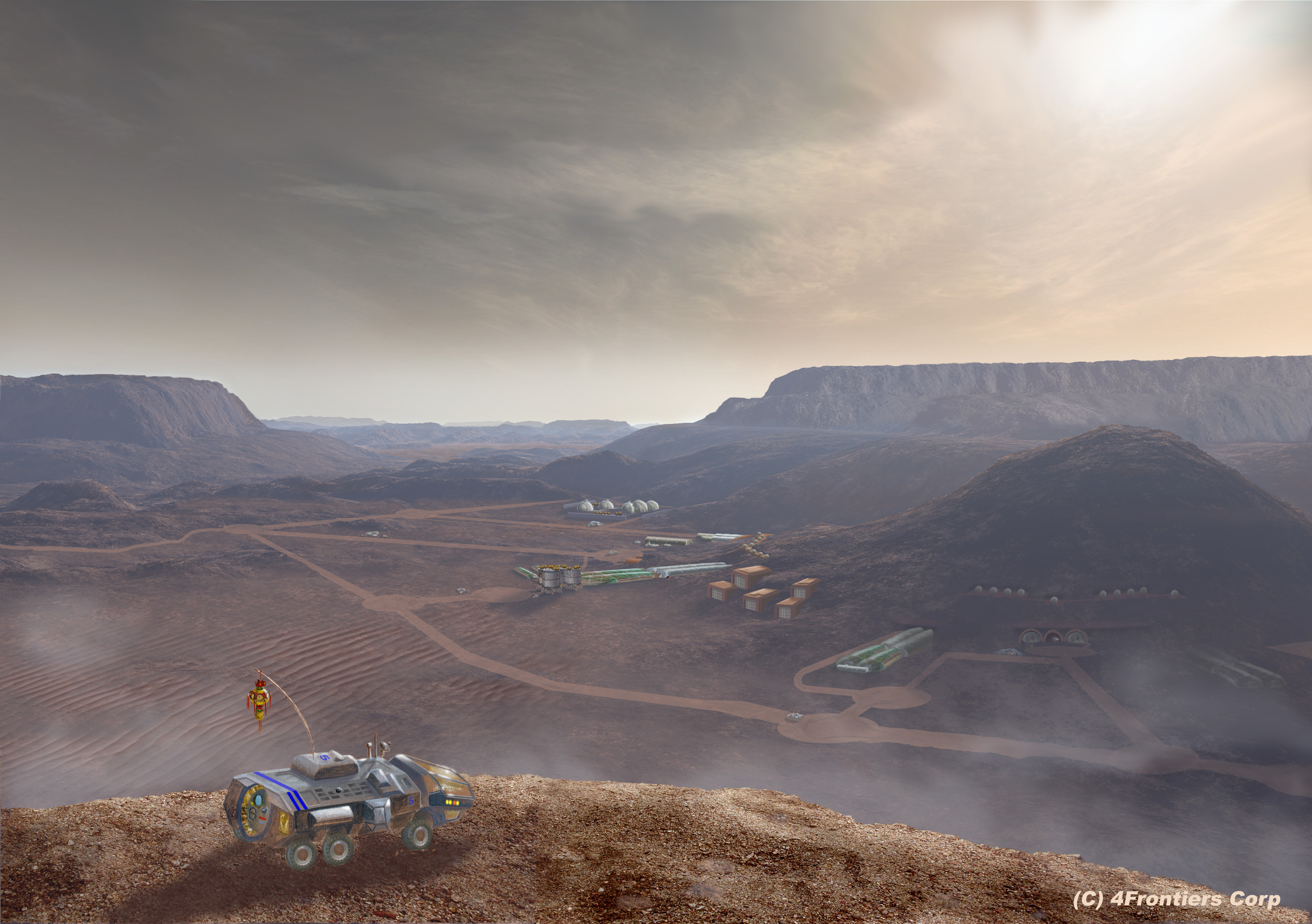
By Piers Bizony
I am endlessly curious about the logic of NASA’s hardware designs and mission architectures, but I am a writer by trade and an engineer only in the armchair sense. My “mission” is to keep people interested in the possibilities of space exploration and persuade them that the collective global investment—in tax dollars, euros, rubles, yuan, and yen—is justified. Mine is an engineering challenge of sorts: manipulating the responses of as many individuals as I possibly can so as to keep them on my side. Every vote counts. Writing as one who believes that human expansion into space is virtuous, and for whom NASA represents a wonder of the civilized world, I am now going to play devil’s advocate. Let us not deny that quite a lot of folk don’t think the way I do. Some of them doubt that the federal government should continue to have a central role in sustaining human space flight. Those are the people that we NASA advocates have to reach.
Half a century ago, at the very dawn of the space age, government advisors prided themselves on their supposed ability to identify potentially useful areas for large-scale national research, such as aviation, computing, rocketry, and nuclear energy. Today it’s all anyone can do to just keep in touch with the bewildering pace of developments in medicine, genetics, electronic consumer goods, personal computing, and global communication. Policymakers are hard-pressed merely to cope with these myriad advances, let alone urge their invention. Even the bombs and missiles that were once our darkest pride have lost their edge in an era of “asymmetrical warfare.” A few fanatics with dime store craft knives can change the world in a day, while the intercontinental ballistic missiles and their costly megatons stay sealed in their silos, impotent in a world that barely even worries about them anymore.
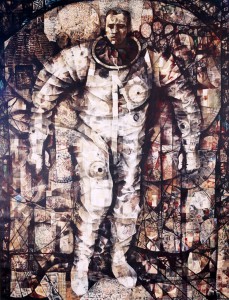
“First Steps 1963,” by Mitchell Jamieson
In this silver-colored spacesuit, Astronaut Gordon Cooper steps away from his Mercury spacecraft and into the bright sunlight on the deck of the recovery ship after twenty-two orbits of Earth. Jamieson spent two weeks in mid-Pacific Ocean awaiting Cooper’s return. He documented the recovery and medical examination and accompanied the astronaut and recovery team back to Cape Canaveral.
Image courtesy the NASA Art Program
As for space exploration, that ambiguous child of the Cold War, let’s face the uncomfortable truth that most launch vehicles are based, essentially, on antique technology. They have advanced less in the fifty years since their invention than just about any other vehicle except for the automobile. The public senses this and turns its attention to newer, sexier technological stimulations, such as iPods and the Internet. There is a problem in the language of space if young people no longer find quite as much excitement in the adventure as their parents and grandparents did fifty years ago, when they, in their turn, were young. To be sure, many thousands of people are still fascinated by space exploration, and millions more take at least a passing interest, but those multitudes may no longer be sufficient to ensure a long-term continuation of human space flight at a major national level.
in the language of space if young people no longer find quite as much excitement in the adventure as their parents and grandparents did fifty years ago, when they, in their turn, were young. To be sure, many thousands of people are still fascinated by space exploration, and millions more take at least a passing interest, but those multitudes may no longer be sufficient to ensure a long-term continuation of human space flight at a major national level.
NASA’s Web sites are beautifully designed and filled with fabulous images, texts, and download options. I have to assume that these vast electronic resources reflect the Agency’s overall public posture. The “how” of getting into space is always perfectly expressed, but the “why” sometimes absents itself. This is because the “why” is not a question that can easily or fully be answered in terms of immediate economic benefits, scientific rewards, or educational spin-offs. The “why” of space exploration is a matter of emotions and instincts.
As a government entity funded by taxpayers, NASA has to be extraordinarily careful how it describes its motivations. The safety of a collective mission statement protects NASA from potentially damaging criticism but at the same time eliminates much of the emotional drama of the Agency’s work, because its public communications have to be checked against the possibility of annoying Main Street or Capitol Hill. Of course there is nothing that NASA can do about this. It is part and parcel of being a federal organization with an obligation to reach out to a wide constituency without alienating any part of that constituency.
It is difficult for NASA to talk, for instance, about the spiritual or emotional aspects of space, because there are more opinions about such matters than you can shake a stick at. Apollo 11’s Michael Collins once said, “I think a future flight should include a poet, a priest, and a philosopher. Then we might get a much better idea of what we saw.” We can only imagine the chaos that would ensue if one kind of priest was selected over another. As for the prospect of philosophers arguing semantics aboard a spacecraft—well, the mind boggles. It is easy to understand why NASA sticks to selling space in terms of scientific and societal benefits: themes that can be expressed in terms that taxpayers and politicians can argue about rationally.

“Apollo 8 Coming Home,” by Robert McCall
For the first time, human eyes directly observed the far side of the moon on Christmas Eve 1968. The Apollo 8 rocket engine was fired to bring the spacecraft out of its lunar orbit and home to Earth. McCall created this oil on canvas piece in 1969.
Image courtesy the NASA Art Program
Rationality is the only tool that can help us decide how a space mission can be done, and how it should be funded. However, when it comes to winning support for that funding, I think that NASA may be missing a trick or two. I propose that it should make greater use of what the intelligence agencies might describe as “deniable assets.” I mean the people who can best express the poetry, the drama, the emotion, the glory, and, yes—although it is essentially a taboo subject—the thrilling dangers of flying into space, while at the same time not being official spokespeople for NASA.
Artists, I believe, should have more of a role in NASA’s public relations strategy. I adore the wonderful computer graphics of hardware concepts, from John Frassanito’s company and many others employed by NASA. I’m a total junkie for that stuff—my downloading habit verges on the alarming—but in this article I am talking about expressive artists, writers, and performers, not realistic illustrators or technical journalists.
A little history. In 1962 Hereward Cooke of the National Gallery of Art in Washington, D.C., wrote a letter of invitation to a number of prominent artists, inviting them to tour NASA and create works based on their impressions. He was eloquent about the need for both art and science in any space endeavor: “When a major rocket launch takes place, more than two hundred cameras record every split second of the activity,” he wrote. “Every nut, bolt, and miniaturized electronic device is photographed from every angle. But the camera sees everything and understands nothing. It is the emotional impact, the interpretation and hidden significance of these events, that lie within the scope of the artist’s vision.” Cooke assured the selected artists that they would be given access to NASA facilities and would be subjected to no editorial pressures whatsoever.
Paul Calle, famous for his scenes of life in the Old West, took up the challenge, producing superb pencil drawings of astronauts and their capsules. Robert Rauschenberg’s semiabstract silk-screen prints seem both celebratory and mildly sarcastic at the same time; Bob McCall, a well-known aerospace illustrator, delivers romantic yet technically accurate pictures to satisfy space hardware buffs; and Lamarr Dodd captures an impressionistic morass of wires, switches, cables, and dials, with silver-clad humans embedded in the machinery of their ships.
Jamie Wyeth’s delicate watercolors show the forlorn scrublands surrounding the launchpads. Rockets, with their barely constrained capacity for disaster (admit it, revel in it), have to keep their distance from the everyday human realm of towns and streets and family backyards. This is a dark yet thrilling truth that artists can explore more freely, perhaps, than NASA press officers. The drab safety-zone territories around Wyeth’s launchpads are a sort of endless “nowhere,” inhabited neither by man nor machine: a wasteland for explosions to vent their fury without causing more harm than necessary.
A more inward landscape is explored by Mitchell Jamieson, who understands the psychological drama behind the Space Age’s political and technological rhetoric. It needs only the lightest sweep of an artist’s brush to expose the religious and mystical desires implicit in cosmic exploration. Jamieson’s painting of a geometrically fragmented astronaut in his spacesuit brings to mind the saintly figures in a cathedral’s stained-glass window.
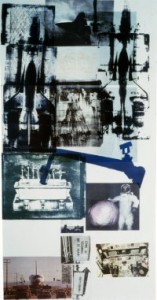
“Hot Shot,” by Robert Rauschenberg
Rauschenberg attended the first launch of the Space Shuttle Columbia in April 1981. This lithograph captures elements of the shuttle, Kennedy Space Center, and the space culture of the Cocoa Beach area around Cape Canaveral.
Image courtesy the NASA Art Program
The art collection that emerged from the efforts of Cooke and his collaborators grew into a major body of work, which is now under the guardianship of the Smithsonian Institution’s Air and Space Museum. However, I am sad to observe that times have changed.
Last year, in London, I was fortunate to hear the singer and performance artist Laurie Anderson talk about space: “I was the first NASA artist in residence. And I was the last artist in residence.” Five years ago, she accepted a yearlong commission to haunt the corridors of various NASA field centers and respond, in her inimical way, to what she saw and heard. With her penchant for dreamlike electronic experimentation and restless curiosity about modern technological culture, she was the perfect artist to take a quirky, sideways look at the space business and to bring those observations to thousands of her fans, people not necessarily familiar with NASA’s work.
Last year, in London, I was fortunate to hear the singer and performance artist Laurie Anderson talk about space: “I was the first NASA artist in residence. And I was the last artist in residence.” Five years ago, she accepted a yearlong commission to haunt the corridors of various NASA field centers and respond, in her inimical way, to what she saw and heard. With her penchant for dreamlike electronic experimentation and restless curiosity about modern technological culture, she was the perfect artist to take a quirky, sideways look at the space business and to bring those observations to thousands of her fans, people not necessarily familiar with NASA’s work.
At the same time, the subjectivity of our individual responses to space is not something that NASA itself can afford to tangle with. Therefore, I reiterate that the Agency should be allowed to communicate through independent artists and writers and musicians in order to reach as wide a spectrum of society as possible. Then, when some artist or other says something “controversial,” NASA can properly distance itself from that artist’s views. The point is not for artists to “toe the company line.” The point is for them to put space flight into the culture so that it becomes something more than a niche activity for aerospace professionals.
Scientific discoveries in space are only half the story. It’s what we make of those discoveries that counts; and, inevitably, what we make of them is subjective and open to debate. As always, human progress can only come from inside ourselves. We can’t find it “out there,” no matter how far we travel, or how complex our spaceships become. According to the British author J. G. Ballard, “The biggest developments of the immediate future will take place not on the moon or Mars, but on Earth, and it is inner space, not outer, that needs to be explored. Even in space, the most alien creatures we’ll confront are ourselves.” And that subject—in the end, the only subject that matters to any of us— is beyond the ability of NASA’s scientists and engineers alone to convey to the public. They also need artists.







